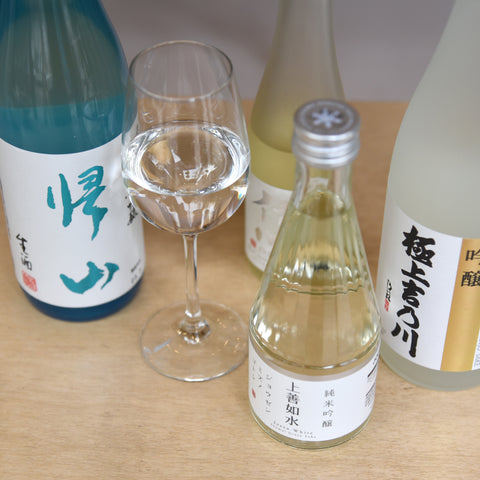Shochu Gumi is our quarterly subscription service with 80+ members throughout the country. Join today!
Looking back at 2023, we had some amazing club bottles, didn’t we?!? These past few quarters I have brought in shochus from Japan just for the club, and I hope to continue this as much as possible going into the new year. I truly believe that our club is super special and want to thank you for being a member of America’s ONLY Shochu Club! Having exclusive bottles makes the club fun for all of us, and I’m thankful to our vendors who partner with me to bring in exceptional shochus from Japan that are little known stateside (it’s a painstaking endeavor that involves label approval from the government so it is no small feat!).

This quarter, I’m stoked to bring you two stunning bottles – from label to juice – that are exclusive to the club. They are distinctly bold and charismatic and will fit right in with your holiday spread. Kuroki Honten should be no stranger to you all, as their shochus Naka Naka and Hyakunen no Kodoku are best sellers at our shop. Located in majestic Miyazaki, they grow their own ingredients for their shochus, and fifth generation President Shinsaku Kuroki designs their chic bottles. Kuroki-san says, "We are so lucky to have such beautiful nature in Miyazaki, and by taking great care of it, in turn it can help us to keep making great shochu." Kuroki Honten itself was established in 1885 and more recently they opened Osuzuyama Distillery, where they make their newer releases of gins and whiskies. Our good friend Ian Rittmaster had the opportunity to visit them in 2022 – make sure to check out all the photos of the distillery and farms on our blog.
 Barley grown in Fukuoka. Photo by Ikekame Shuzo.
Barley grown in Fukuoka. Photo by Ikekame Shuzo.
On other side of Kyushu, in Fukuoka, I visited Ikekame Shuzo earlier this year where they make both sake and shochu. President Teruyuki Kamachi says, “The land is fertile, and double cropping is practiced in which rice is grown after wheat is harvested.” Honestly, this label first stopped me in my tracks, and I had to get my hands on it for the club! The face is a Mingei depiction of Kintaro (a folk tale of a boy with superhuman strength), used in local folk art. President Teruyuki Kamachi told me that as a boy, he would fly a kite with this face on it, which symbolized strength and good health for small children. The region is well-known for sake production, and Ikekame started making shochu in 1984 when, “the sake market was in a slump.” Kamachi-san oversees both sake and shochu production and aims to “make alcohol that I would like to drink myself.”
Kanpai to that! Happy Holidays,
Kayoko
+++

Ouka Imo Shochu
Kuroki Honten Distillery (Takanabe, Miyazaki)
Distilled from estate grown Tama Akane sweet potatoes and local Hinohikari rice
ABV 25% / Koji: Black / Distillation: Atmospheric
Aged in resin-coated iron vats

Sweet potato field at Kuroki Honten Distillery. Photo by Ian Rittmaster
Made with handmade koji and a sweet potato called Tama Akane that is grown on Kuroki Honten’s farm, this a variety that is radiant orange in color has a high level of beta carotene. About Ouka, Kuroki-san says, “it is a valuable shochu because the potato is dicult to steam and the amount of alcohol that can be removed is small.” With strong notes of black tea, orange blossoms and vanilla (Celestial Seasoning’s Mandarin Orange Spice Tea, anyone?), this aromatic shochu brightens in any service style, even cocktails.
Food Pairing:
Buttermilk fried chicken
Camino Grilled Crab
How to Drink:
Sodawari (with club soda and ice)
Oyuwari (with hot water - see below)
Gimlet Cocktail: 2oz Ouka, 0.5oz lime, 0.5oz simple syrup. Shake for 10-15 seconds, pour into a coupe, garnish with lime peel.
+++

Chikugo Agura Kintaro Mugi Shochu
Ikekame Shuzo (Kurume, Fukuoka)
Distilled from local Hoshun mugi (barley) and barley koji
ABV 25% / Koji: Black / Distillation: Atmospheric
Aged in enamel tanks for 3 years
 President Kamachi and Kayoko in front of the brewery.
President Kamachi and Kayoko in front of the brewery.
Ikekame Shuzo is relatively new to shochu-making in comparison to their sake-making history of nearly 150 years. President Kamachi says, “We aim to create shochu that expresses the characteristics of the ingredients and the local climate” and for this bottle, Fukuoka barley is used. The result is a shochu with a buttery texture and notes of toast and chocolate with a cinnamony, burnt sugar tail.
Food Pairing:
Prime Rib
Holiday cheese board with charcuterie, hoshigaki, and nuts
How to drink:
Oyuwari
2 ounces in hot chocolate!
How to Make Oyuwari
Pour 2 ounces of hot water into a cup, then add 3 ounces of shochu.
Do it in this order or else you will burn the shochu!




Comments (0)
There are no comments for this article. Be the first one to leave a message!